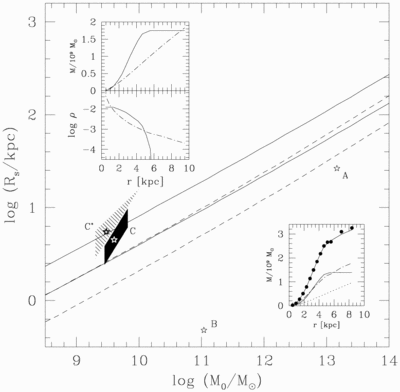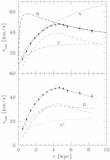Image Details

Caption: Fig. 2.
Standard cluster normalized cold dark matter models predict that the dark matter halo scale radii ﹩R_{s}﹩ and scale masses ﹩M_{0}﹩ should lie within the narrow band enclosed by the two parallel solid lines. The parallel dashed lines enclose the region of scale parameters, expected for the less favored COBE‐normalized cold dark matter model. One‐component dark matter fits to the rotation curve of DDO 154 would result in scale parameters as shown by the two stars for the inner (A) and outer (B) fits. The two‐component MACHO model without adiabatic contraction and with adiabatic contraction requires the scale parameters to lie within the dark area (labeled C) and the shaded area (labeled C*), respectively. Top inserts show the mass and density distribution (ρ in units of ﹩M_{\odot }﹩ pc−3) for the standard model (﹩M_{0}=4\times 10^{9}\,M_{\odot }﹩, ﹩R_{s}=4.5﹩ kpc, star inside dark area) without adiabatic contraction, with the solid and dashed lines representing the dark baryonic spheroid and the dark matter halo, respectively. Bottom insert shows the mass distribution of the standard model (﹩M_{0}=3\times 10^{9}\,M_{\odot }﹩, ﹩R_{s}=5.5\,\mathrm{kpc}\,﹩, star inside shaded area) with adiabatic contraction. The dots represent the total dark matter mass profile as predicted from the rotation curve. The lower solid line shows the mass profile of the MACHO halo. The dot‐dashed and the dotted curves show the mass distribution of the nonbaryonic dark matter halo after and before adiabatic contraction, respectively.
Copyright and Terms & Conditions
© 1997. The American Astronomical Society. All rights reserved. Printed in U.S.A.




